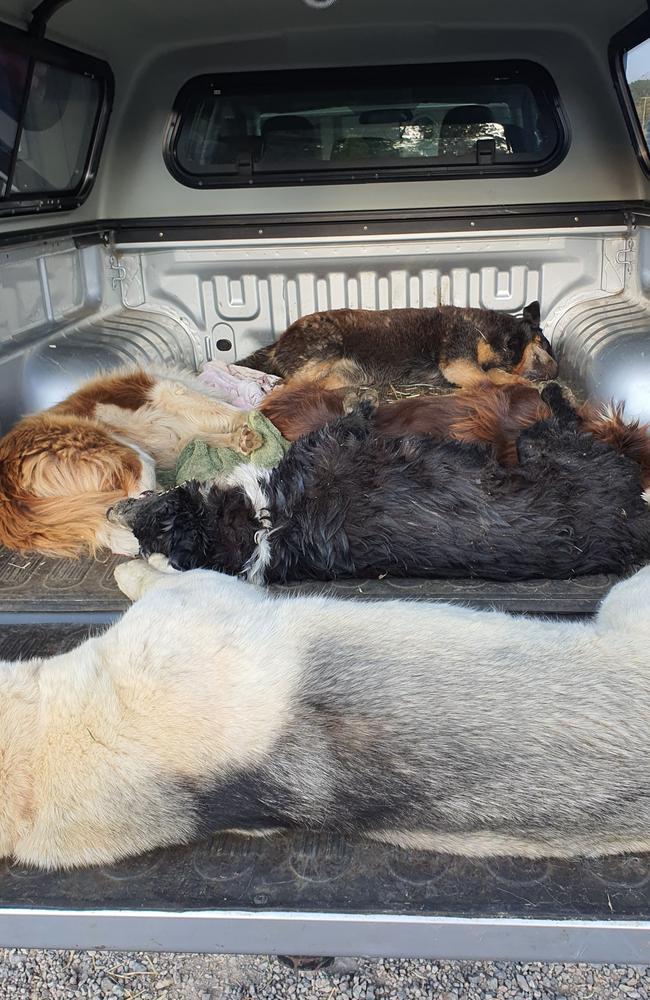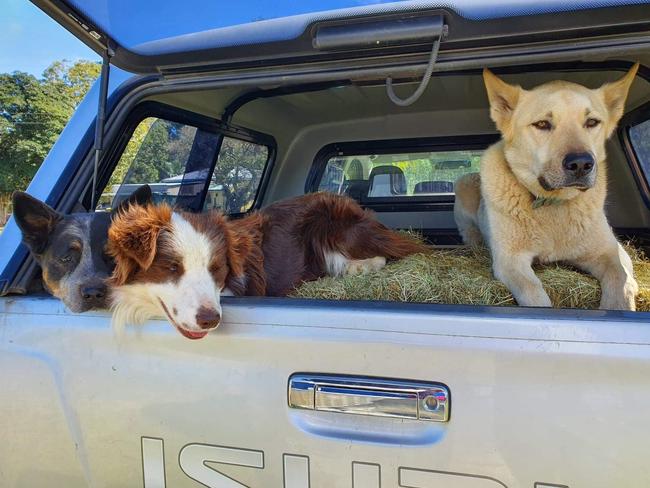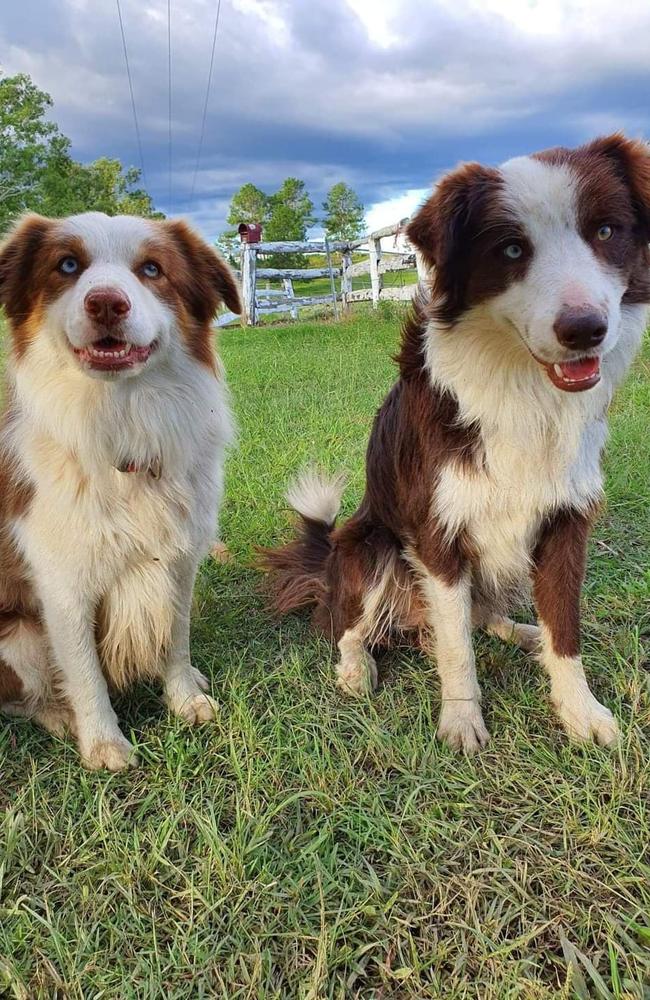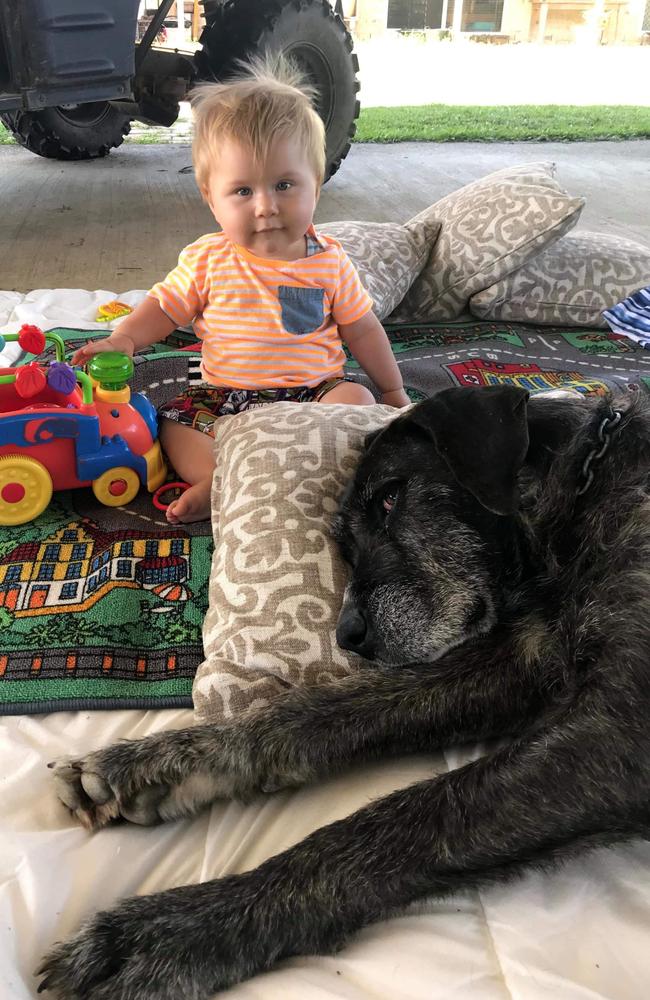Five dogs dead in five hours from suspected 1080 poisoning in Moreton Bay region
Thrashing around with their ‘eyes popping out of their heads’, five dogs died horrific deaths in five hours after a suspected baiting. It was just one of many recent incidents across Queensland with shocked families demanding answers as authorities dodge the blame. WARNING: DISTRESSING
QLD News
Don't miss out on the headlines from QLD News. Followed categories will be added to My News.
WARNING: DISTRESSING CONTENT
CANDICE Gurtner looked at the five dead dogs in the back of the ute in shock.
“We didn’t know what to do or what to say. We put the fifth one in the back of the ute and just thought ‘What the hell just happened? What did we do to deserve this?’,” she said.
A day later, another family’s pet dog also suddenly died in the same agonising way – of suspected 1080 poisoning – in the same area of Moreton Bay.
The chemical sodium fluoroacetate, commonly known by its brand name of 1080, is a highly toxic pesticide that is used to kill introduced “pest animals” such as feral dogs, foxes, cats, rabbits, pigs, and in some cases, native wildlife.
Many proponents of baiting state 1080 is essential for farmers, and that it is safe for most native animals.
But two devastated farm families have joined the call to have it banned after suddenly losing their dogs to someone else’s suspected 1080 baits within 24 hours.

‘WRITHING IN PAIN’: ANGRY DOG OWNERS DEMAND BAITING BAN
September 4 had started out like any other day for Miss Gurtner, 28, and her partner Donna Taylor, 35 of Stanmore, near Woodford.
Ms Taylor took their five dogs on a regular 6.30am trail ride through a state forest – where animals are permitted.
A few hours later Miss Gurtner said helpless family members watched in despair as each dog suddenly started screaming and thrashing around as they succumbed to - what was later determined to be suspected 1080 poisoning - one by one.
“About 11.30am we had the farrier out doing the horses feet,” she said.

“Kobi, our one-year-old border collie, was about two metres away from me.
“Within five minutes of the farrier arriving, Kobi just started suddenly screaming and howling. He was going off and urinating everywhere.
“He ran back over and between us. Then he got up and started convulsing and having a seizure on the ground.”
GRIEVING PET OWNERS CALL FOR 1080 BAN
MAREMMA PUPPY’S VIGIL AT FRESH GRAVE
A moment later, four-year-old Gypsy the blue heeler lodged herself under a car and also started having convulsions.
When Miss Gurtner tried to reach her, Gypsy “turned aggressive.”
“She actually bit me on the hand and she’s the friendliest dog ever,” she said.
“We quickly grabbed both her and Kobi and rang the Kilcoy vet and said we were on our way.
“They were throwing themselves around in the back of the (covered) ute and their eyes were just popping out of their heads.”
Both dogs were dead by the time the women pulled up at the vet, 30 minutes later.
They were still there when Miss Gurtner’s father rang to tell them Bruno, their four-year-old border collie, was also now dead on the 20 acre Nonmus Road property.
Minutes after returning home and walking in the gate, 10-year-old border collie kelpie cross Nitro suddenly bolted past them and down the road “at full speed.”
The women later found Nitro in a creek on a neighbour’s property and arrived home with her body about 1.30pm.

About 5pm, Hero, a two-year-old German Shepherd Husky cross, suddenly died screaming and thrashing around in the same distressed way.
Miss Gurtner said discussions with the vet indicated the dogs had likely ingested meat baited with the pesticide 1080.
“There was no denying it was 1080, and it doesn’t take a scientist to work out that it was 1080,” she said.
The corrections officer said on past occasions, bait warning signs had been posted in the area and families notified, as is required by legislation, but this time there were no signs nearby and the family had received no notification.

The following day, Katrina Burley, 30, and her family visited her parents on their 300 acre Woodford home for an early Father’s Day celebration.
They took their Great Dane Wolfhound cross, Cash, with them as they had done many times before.
Miss Burley said the family, including three young children, were sitting on a patio after a morning of fun when the seven-year-old dog vomited.
“All of a sudden he bolted and started yelping so loud. He ran straight through everyone at the table,” she said.
“He ran back out and he was convulsing and fitting. … He got back up and he was full pelt running into sheds and trailers, started convulsing and frothing out of his mouth.”

Miss Burley said she rang a vet but it would be at least 45 minutes before an emergency vet could reach them.
“It was the worst thing I’ve ever seen I would never wish this on any animal,” she said.
Miss Burley said properties in the area did, on occasion legally use the bait, but their family had never had a problem with it before.
“We don’t use it at all as we don’t agree with it,” she said.
She said there was a bait warning sign on Fredin Road that day but Cash had been with them all morning and not left property.
“Dad said Cash came into the backyard with something, but he scoffed it before the other dogs did” Miss Burley said.
“Mum called the council to ask about how toxic the 1080 was to other dogs. She was told if they even lick another dog’s mouth or where it was thrown up, the other dogs could still get sick from it too, so to keep them inside for up to a week.”
Miss Gurtner said 1080 should be banned.
“It’s completely inhumane and it should be illegal,” she said.
“I wouldn’t want any animal, whether a domestic pet or a pest, to die like that.”
The council response
Moreton Bay Regional Council Mayor Peter Flannery disputed the claim the owners of the five dogs never received notification.
“Advice letters to property owners specifically stated that no baits are located on council or state land and are only located on private property,” he said, through a media spokesman.
“Sadly this was an entirely preventable situation, if only the dog owner … heeded the advice provided in the Council notification.
“The animals’ owner was explicitly told that baits were being used in that area to protect farms from feral animals, however they still allowed their pets to run uncontrolled off-leash.
“The cause of the death of the dogs is unknown as toxicology reports were not completed.”
Mr Flannery did not respond to questions about Cash, the dog that died on a different property the following day.
Although she admits the five dogs were off-lead, Miss Gurtner said the dogs never left the house or entered private property.
They were also secured at night and when no one was home.
“On lead or off, my question is why no signage?” she said.
“We would never put our dogs at risk running in the forestry if we had known they baited in there.
“My sister rang the council on our behalf that Friday as we were too distressed. She was passed around to six people.
“The sixth person said there had been bait five metres inside the forestry area, instead of it being five metres inside the fence of the private property that is about 600 metres away from the forest.”

Government involvement
A spokesman for the Department of Environment and Science said no baits had been placed by that department in the state forest.
“DES did not set any baits in the state forest,” he said.
“This is either a council or landowner issue.”
A spokeswoman for the Australian Pesticides and Veterinary Medicines Authority (APVMA) – the independent statutory authority responsible for the assessment, registration and regulation of agricultural and veterinary chemicals in Australia – declined a request for an interview on the topic of 1080 and asked questions from the Courier Mail to be emailed.
She then declined to answer several, specific questions and instead replied with a written statement, that said the authority classified 1080 as a restricted chemical product (RCP).
“RCPs can only be supplied to persons who have completed relevant training and/or met other requirements, and are authorised to use the product under the laws of a state or territory,” she wrote.
“State and territory authorities are responsible for investigating suspected instances of noncompliance with label directions, including non-recovery of bait and carcasses, and instances of poisoning of non-target animals.”
A Biosecurity Queensland spokesman said 1080 could only be supplied as prepared baits.
“Since the 1970s, the Department of Agriculture and Fisheries (DAF) has provided 1080 concentrate to local councils or landholders to control wild dogs, feral pigs, foxes, feral cats and rabbits,” he said.
“1080 is the most humane, economic and species-specific toxin available for invasive animal control in Australia. (It) is widely used … to protect agricultural production and native flora and fauna from the impacts of invasive animals.
“The use of 1080 in some conservation areas allows the continued survival of rare and threatened wildlife and assists in the reintroduction of species into areas where they have previously been locally extinct.”
The spokesman said rural landholders had the option of using manufactured baits or capsules for canid pest ejectors, or 1080 fresh meat baits.

A 2017 Biosecurity Queensland publication states many mammals, birds and reptiles have developed a much higher tolerance to 1080 than introduced animals, due to their evolution with naturally occurring fluoroacetate in some native plants.
“The dose rates used in declared pest animal control, coupled with responsible baiting practices, mean that the chances of killing native animals are minimised,” it states.
A 2019 DAF publication advises Queensland Health should be contacted if a non-target animal is suspected of dying as a result of the poison.
“If non-target animals are suspected of dying as a result of a 1080 baiting program, Queensland Health should be contacted so that it can be properly investigated and, where possible, the appropriate test be undertaken,” it states.
A Queensland Health spokeswoman declined to make anyone available for an interview despite two requests over a week, and instead asked for questions to be emailed.
The spokeswoman then declined to answer the specific questions and instead released a written statement.
“Strict requirements exist for the use and placement of 1080 baits to ensure community safety and reduce the risk of accidental poisoning of non-target animals,” she wrote.
“The manufacture, supply and use of 1080 in Queensland is strictly regulated under the Health (Drugs and Poisons) Regulation 1996.
“Offences for misuse of 1080 are prescribed in the Regulation, which is administered by Queensland Health.”
